Acoustic Detection Module Design of a Quartz-Enhanced Photoacoustic Sensor
Abstract
:1. Introduction
2. Guidelines for the Design of an ADM
3. Standard QTF-Based ADM
3.1. On-Beam AmR Configuration of QEPAS Spectrophone
3.2. Standard QTF-Based ADM for Lab Applications
3.3. Standard QTF-Based ADM for Industrial Applications
4. Custom QTF-Based ADM
5. Conclusions
Funding
Conflicts of Interest
References
- Kosterev, A.A.; Bakhirkin, Y.A.; Tittel, F.K.; Mcwhorter, S.; Ashcraft, B. QEPAS methane sensor performance for humidified gases. Appl. Phys. B 2008, 92, 103–109. [Google Scholar] [CrossRef]
- Jahjah, M.; Ren, W.; Stefański, P.; Lewicki, R.; Zhang, J.; Jiang, W.Z.; Tarka, J.; Tittel, F.K. A compact QCL based methane and nitrous oxide sensor for environmental and medical applications. Analyst 2013, 139, 2065–2073. [Google Scholar] [CrossRef] [PubMed]
- Yin, X.K.; Dong, L.; Wu, H.P.; Zheng, H.D.; Ma, W.G.; Zhang, L.; Yin, W.B.; Jia, S.T.; Tittel, F.K. Sub-ppb nitrogen dioxide detection with a large linear dynamic range by use of a differential photoacoustic cell and a 3.5 W blue multimode diode laser. Sens. Actuators B Chem. 2017, 247, 329–335. [Google Scholar] [CrossRef]
- Zheng, H.D.; Lou, M.H.; Dong, L.; Wu, H.P.; Ye, W.L.; Yin, X.K.; Kim, C.S.; Kim, M.J.; Bewley, W.W.; Merritt, C.D.; et al. Compact photoacoustic module for methane detection incorporating interband cascade light emitting device. Opt. Express 2017, 25, 16761–16770. [Google Scholar] [CrossRef] [PubMed]
- Ma, Y.F.; Tong, Y.; He, Y.; Yu, X.; Tittel, F.K. High-power DFB diode laser-based CO-QEPAS sensor: Optimization and performance. Sensors 2018, 18, 122. [Google Scholar] [CrossRef] [PubMed]
- Kosterev, A.A.; Tittel, F.K.; Serebryakov, D.V.; Malinovsky, A.L.; Morozov, I.V. Applications of quartz tuning forks in spectroscopic gas sensing. Rev. Sci. Instrum. 2005, 76, 043105. [Google Scholar] [CrossRef]
- Liu, K.; Li, J.; Wang, L.; Tan, T.; Zhang, W.; Gao, X.; Chen, W.; Tittel, F.K. Trace gas sensor based on quartz tuning fork enhanced fork enhanced laser photoacoustic spectroscopy. Appl. Phys. B 2009, 94, 527–533. [Google Scholar] [CrossRef]
- Patimisco, P.; Sampaolo, A.; Dong, L.; Tittel, F.K.; Spagnolo, V. Recent advances in quartz enhanced photoacoustic sensing. Appl. Phys. Rev. 2018, 5, 011106. [Google Scholar] [CrossRef]
- Florian, S. Laser-Based Absorption Spectrometry. Ph.D. Thesis, Umeå University, Umeå, Sweden, 2007. [Google Scholar]
- Kosterev, A.A.; Buerki, P.R.; Dong, L.; Reed, M.; Day, T.; Tittel, F.K. QEPAS detector for rapid spectral measurements. Appl. Phys. B 2010, 100, 173–180. [Google Scholar] [CrossRef]
- Ma, Y.F. Review of recent advanced in QEPAS-based trace gas sensing. Appl. Sci. 2018, 8, 1822. [Google Scholar] [CrossRef]
- Tittel, F.K.; Bakhirkin, Y.; Kosterev, A.A.; Lewicki, R.; So, S.; Wysocki, G.; Curl, R.F. Recent advances and applications of mid-infrared based trace gas sensor technology. In Proc. SPIE 6900, Quantum Sensing and Nanophotonic Devices V; International Society for Optics and Photonics: Bellingham, WA, USA; Cardiff, UK, 2008; Volume 6900, p. 69000Z. [Google Scholar]
- Tittel, F.K.; Curl, R.F.; Dong, L.; Doty, J.H.; Kosterev, A.A.; Lewicki, R.; Thomazy, D.; Wysocki, G. Recent advances in infrared semiconductor laser based chemical sensing technologies. NATO Sci. Peace Secur. Ser. B Phys. Biophys. 2011, 24, 165–173. [Google Scholar]
- Kosterev, A.A.; Wysocki, G.; Bakhirkin, Y.; So, S.; Lewicki, R.; Fraser, M.; Tittel, F.K.; Curl, R.F. Application of quantum cascade lasers to trace gas analysis. Appl. Phys. B 2008, 90, 165–176. [Google Scholar] [CrossRef]
- Spagnolo, V.; Patimisco, P.; Sampaolo, A.; Pennetta, R.; Cumis, M.S.; Viciani, S.; Borri, S.; Natale, P.D.; D’Amato, F.; Vitiello, M.S.; et al. QEPAS-enhanced photoacoustic sensors for H2S trace gas detection. In Proc. SPIE 9370, Quantum Sensing and Nanophotonic Devices XII; International Society for Optics and Photonics: Bellingham, WA, USA; Cardiff, UK, 2015; Volume 9370, p. 93700Y. [Google Scholar]
- Liu, K.; Guo, X.; Yi, H.; Chen, W.; Zhang, W.; Gao, X. Off-beam quartz-enhanced photoacoustic spectroscopy. Opt. Lett. 2009, 34, 1594–1596. [Google Scholar] [CrossRef] [PubMed]
- Liu, K.; Yi, H.M.; Kosterev, A.A.; Chen, W.D.; Dong, L.; Wang, L.; Tan, T.; Zhang, W.J.; Tittel, F.K.; Gao, X.M. Trace gas detection based on off-beam quartz enhanced photoacoustic spectroscopy: Optimization and performance evaluation. Rev. Sci. Intrum. 2010, 81, 103103. [Google Scholar] [CrossRef] [PubMed]
- Yi, H.M.; Liu, K.; Sun, S.W.; Zhang, W.J.; Gao, X.M. Theoretical analysis of off beam quartz-enhanced photoacoustic spectroscopy sensor. Opt. Commun. 2012, 285, 5306–5312. [Google Scholar] [CrossRef]
- Yi, H.M.; Chen, W.D.; Sun, S.W.; Liu, K.; Tan, T.; Gao, X.M. T-shape microresonator-based high sensitivity quartz-enhanced photoacoustic spectroscopy sensor. Opt. Express 2012, 20, 9187–9196. [Google Scholar] [CrossRef] [PubMed]
- Yi, H.M.; Chen, W.D.; Vicet, A.; Cao, Z.S.; Gao, X.M.; Nguyen-ba, T.; Jahjah, M.; Rouillard, Y.; Nähle, L.; Fischer, M. T-shape mic-roresonator-based quartz-enhanced photoacoustic spectroscopy for ambient methane monitoring using 3.38-μm antimonite-distributed feedback laser diode. Appl. Phys. B 2014, 116, 423–428. [Google Scholar] [CrossRef]
- Zheng, H.D.; Dong, L.; Sampaolo, A.; Wu, H.P.; Patimisco, P.; Yin, X.K.; Ma, W.G.; Zhang, L.; Yin, W.B.; Spagnolo, V.; et al. Single-tube on-beam quartz-enhanced photoacoustic spectroscopy. Opt. Lett. 2016, 41, 978–981. [Google Scholar] [CrossRef] [PubMed]
- Zheng, H.D.; Dong, L.; Sampaolo, A.; Patimisco, P.; Ma, W.G.; Zhang, L.; Yin, W.B.; Xiao, L.T.; Spagnolo, V.; Jia, S.T.; et al. Overtone resonance enhanced single-tube on-beam quartz enhanced photoacoustic spectrophone. Appl. Phys. Lett. 2016, 109, 111103. [Google Scholar] [CrossRef] [Green Version]
- Zheng, H.D.; Dong, L.; Wu, H.P.; Yin, X.K.; Xiao, L.T.; Jia, S.T.; Curl, R.F.; Tittel, F.K. Application of acoustic micro-resonators in quartz-enhanced photoacoustic spectroscopy for trace gas analysis. Chem. Phys. Lett. 2018, 691, 462–472. [Google Scholar] [CrossRef]
- Sampaolo, A.; Patimisco, P.; Gluszek, A.; Hudzikowski, A.; Giglio, M.; Zheng, H.D.; Tittel, F.K.; Spagnolo, V. A Low power consumption quartz-enhanced photoacoustic gas sensor employing a quantum cascade laser in pulsed operation. In Proc. SPIE 10111, Quantum Sensing and Nano Electronics and Photonics XIV; International Society for Optics and Photonics: Bellingham, WA, USA; Cardiff, UK, 2017; Volume 10111, p. 101110C. [Google Scholar]
- Sampaolo, A.; Patimisco, P.; Giglio, M.; Vitiello, M.S.; Beere, H.E.; Ritchie, D.A.; Scamarcio, G.; Tittel, F.K.; Spagnolo, V. Improved Tuning Fork for Terahertz Quartz-Enhanced Photoacoustic Spectroscopy. Sensors 2016, 16, 439. [Google Scholar] [CrossRef] [PubMed]
- Borri, S.; Patimisco, P.; Sampaolo, A.; Beere, H.E.; Ritchie, D.A.; Vitiello, M.S.; Scamarcio, G.; Spagnolo, V. Terahertz quartz enhanced photo-acoustic sensor. Appl. Phys. Lett. 2013, 103, 021105. [Google Scholar] [CrossRef]
- Spagnolo, V.; Patimisco, P.; Pennetta, R.; Sampaolo, A.; Scamarcio, G.; Vitiello, M.S.; Tittel, F.K. THz Quartz-enhanced photoacoustic sensor for H2S trace gas detection. Opt. Express 2015, 23, 7574–7582. [Google Scholar] [CrossRef] [PubMed]
- Patimisco, P.; Borri, S.; Sampaolo, A.; Beere, H.E.; Ritchie, D.A.; Vitiello, M.S.; Scamarcio, G.; Spagnolo, V. A quartz enhanced photo-acoustic gas sensor based on a custom tuning fork and a terahertz quantum cascade laser. Analyst 2014, 139, 2079–2087. [Google Scholar] [CrossRef] [PubMed]
- Dong, L.; Kosterev, A.A.; Thomazy, D.; Tittel, F.K. QEPAS spectrophones: Design, optimization, and performance. Appl. Phys. B 2010, 100, 627–635. [Google Scholar] [CrossRef]
- Yin, X.K.; Dong, L.; Zheng, H.D.; Liu, X.L.; Wu, H.P.; Yang, Y.F.; Ma, W.G.; Zhang, L.; Yin, W.B.; Xiao, L.T.; et al. Impact of humidity on quartz-enhanced photoacoustic spectroscopy based CO detection using a near-IR telecommunication diode laser. Sensors 2016, 16, 162. [Google Scholar] [CrossRef] [PubMed]
- Spagnolo, V.; Kosterev, A.A.; Dong, L.; Lewicki, R.; Tittel, F.K. NO trace gas sensor based on quartz enhanced photoacoustic spectroscopy and external cavity quantum cascade laser. Appl. Phys. B 2010, 100, 125–130. [Google Scholar] [CrossRef]
- Wysocki, G.; Kosterev, A.A.; Tittel, F.K. Influence of molecular relaxation dynamics on quartz-enhanced photoacoustic detection of CO2 at λ = 2 µm. Appl. Phys. B 2006, 85, 301–306. [Google Scholar] [CrossRef]
- Zheng, H.D.; Dong, L.; Liu, X.L.; Liu, Y.Y.; Wu, H.P.; Ma, W.G.; Zhang, L.; Yin, W.B.; Jia, S.T. Near-IR telecommunication diode laser based double-pass QEPAS sensor for atmospheric CO2 detection. Laser Phys. 2015, 25, 125601. [Google Scholar] [CrossRef]
- Wu, H.P.; Dong, L.; Ren, W.; Yin, W.B.; Ma, W.G.; Zhang, L.; Jia, S.T.; Tittel, F.K. Position effects of acoustic micro-resonator in quartz enhanced photoacoustic spectroscopy. Sens. Actuators B 2015, 206, 364–370. [Google Scholar] [CrossRef]
- Kosterev, A.A.; Tittel, F.K. Ammonia detection by use of quartz-enhanced photoacoustic spectrophone with a near-IR telecommunication diode laser. Appl. Opt. 2004, 43, 6213–6217. [Google Scholar] [CrossRef] [PubMed]
- Zheng, H.D.; Dong, L.; Yin, X.K.; Liu, X.L.; Wu, H.P.; Zhang, L.; Ma, W.G.; Yin, W.B.; Jia, S.T. Ppb-level QEPAS NO2 sensor by use of electrical modulation cancellation method with a high power blue LED. Sens. Actuators B 2015, 208, 173–179. [Google Scholar] [CrossRef]
- Zheng, H.D.; Dong, L.; Ma, Y.; Wu, H.P.; Liu, X.L.; Yin, X.K.; Zhang, L.; Ma, W.G.; Yin, W.B.; Xiao, L.T.; et al. Scattered light modulation cancellation method for sub-ppb-level NO2 detection in a LD-excited QEPAS system. Opt. Express 2016, 24, A752–A761. [Google Scholar] [CrossRef] [PubMed]
- Weidmann, D.; Kosterev, A.A.; Tittel, F.K.; Ryan, N.; McDonald, D. Application of a widely electrically tunable diode laser to chemical gas sensing with quartz-enhanced photoacoustic spectroscopy. Opt. Lett. 2004, 29, 1837–1839. [Google Scholar] [CrossRef] [PubMed]
- Wu, H.P.; Dong, L.; Liu, X.L.; Zheng, H.D.; Yin, X.K.; Ma, W.G.; Zhang, L.; Yin, W.B.; Jia, S.T. Fiber-amplifier-enhanced QEPAS sensor for simultaneous trace gas detection of NH3 and H2S. Sensors 2015, 15, 26743–26755. [Google Scholar] [CrossRef] [PubMed]
- Kosterev, A.A.; Mosely, T.S.; Tittel, F.K. Impact of humidity on quartz-enhanced photoacoustic spectroscopy based detection of HCN. Appl. Phys. B 2006, 85, 295–300. [Google Scholar] [CrossRef]
- Wu, H.P.; Dong, L.; Zheng, H.D.; Liu, X.L.; Yin, X.K.; Ma, W.G.; Zhang, L.; Yin, W.B.; Jia, S.T.; Tittel, F.K. Enhanced near-infrared QEPAS sensor for sub-ppm level H2S detection by means of a fiber amplified 1582 nm DFB laser. Sens. Actuators B 2015, 221, 666–672. [Google Scholar] [CrossRef]
- Kosterev, A.A.; Bakhirkin, Y.A.; Curl, R.F.; Tittel, F.K. Quartz-enhanced photoacoustic spectroscopy. Opt. Lett. 2002, 27, 1902–1904. [Google Scholar] [CrossRef] [PubMed]
- Schilt, S.; Kosterev, A.A.; Tittel, F.K. Performance evaluation of a near infrared QEPAS based ethylene sensor. Appl. Phys. B 2009, 95, 813–824. [Google Scholar] [CrossRef]
- Kosterev, A.A.; Bakhirkin, Y.A.; Tittel, F.K.; Blaser, S.; Bonetti, Y.; Hvozdara, L. Photoacoustic phase shift as a chemically selective spectroscopic parameter. Appl. Phys. B 2004, 78, 673–676. [Google Scholar] [CrossRef]
- Kosterev, A.A.; Bakhirkin, Y.A.; Tittel, F.K. Ultrasensitive gas detection by quartz-enhanced photoacoustic spectroscopy in the fundamental molecular absorption bands region. Appl. Phys. B 2005, 80, 133–138. [Google Scholar] [CrossRef]
- Lewicki, R.; Kosterev, A.A.; Thomazy, D.M.; Risby, T.H.; Solga, S.T.; Schwartz, B.; Tittel, F.K. Real time ammonia detection in exhaled human breath using a distributed feedback quantum cascade laser based sensor. In Proc. SPIE 7945, Quantum Sensing and Nanophotonic Devices VIII; International Society for Optics and Photonics: Bellingham, WA, USA; Cardiff, UK, 2011; Volume 7945, p. 79450K. [Google Scholar]
- Bauer, C.; Willer, U.; Lewicki, R.; Pohlkötter, A.; Kosterev, A.A.; Kosynkin, D.; Tittel, F.K.; Schade, W. A mid-infrared QEPAS sensor device for TATP detection. J. Phys. Conf. Ser. 2009, 157, 012002. [Google Scholar] [CrossRef]
- Horstjann, M.Y.; Bakhirkin, A.; Kosterev, A.A.; Curl, R.F.; Tittel, F.K.; Wong, C.M.; Hill, C.J.; Yang, R.Q. Formaldehyde sensor using interband cascade laser based quartz-enhanced photoacoustic spectroscopy. Appl. Phys. B 2004, 79, 799–803. [Google Scholar] [CrossRef]
- Dong, L.; Wu, H.P.; Zheng, H.D.; Liu, Y.Y.; Liu, X.L.; Jiang, W.Z.; Zhang, L.; Ma, W.G.; Ren, W.; Yin, W.B.; et al. Double acoustic micro-resonator quartz-enhanced photoacoustic spectroscopy. Opt. Lett. 2014, 39, 2479–2482. [Google Scholar] [CrossRef] [PubMed]
- Wu, H.P.; Dong, L.; Zheng, H.D.; Yu, Y.J.; Ma, W.G.; Zhang, L.; Yin, W.B.; Xiao, L.T.; Jia, S.T.; Tittel, F.K. Beat frequency quartz-enhanced photoacoustic spectroscopy for fast and calibration-freecontinuous trace-gas monitoring. Nat. Communs. 2017, 8, 15331. [Google Scholar] [CrossRef] [PubMed]
- Kosterev, A.A.; Tittel, F.K. Advanced quartz-enhanced photoacoustic trace gas sensor for early fire detection. SAE Int. J. Aerosp. 2009, 1, 331–336. [Google Scholar] [CrossRef]
- Kosterev, A.A.; Dong, L.; Thomazy, D.; Tittel, F.K.; Overby, S. QEPAS for chemical analysis of multi-component gas mixtures. Appl. Phys. B 2010, 101, 649–659. [Google Scholar] [CrossRef]
- Dong, L.; Kosterev, A.A.; Thomazy, D.; Tittel, F.K. Compact portable QEPAS multi-gas sensor. In Proc. SPIE 7945, Quantum Sensing and Nanophotonic Devices VIII; International Society for Optics and Photonics: Bellingham, WA, USA; Cardiff, UK, 2011; Volume 7945, p. 79450R. [Google Scholar]
- Dong, L.; Wright, J.; Peters, B.; Ferguson, B.A.; Tittel, F.K.; McWhorter, S. Compact QEPAS sensor for trace methane and ammonia detection in impure hydrogen. Appl. Phys. B 2012, 107, 459–467. [Google Scholar] [CrossRef] [Green Version]
- Dong, L.; Spagnolo, V.; Lewicki, R.; Tittel, F.K. Ppb-level detection of nitric oxide using an external cavity quantum cascade laser based QEPAS sensor. Opt. Express 2011, 19, 24037–24045. [Google Scholar] [CrossRef] [PubMed]
- Dong, L.; Lewicki, R.; Liu, K.; Buerki, P.R.; Weida, M.J.; Tittel, F.K. Ultra-sensitive carbon monoxide detection by using EC-QCL based quartz-enhanced photoacoustic spectroscopy. Appl Phys. B 2012, 107, 275–283. [Google Scholar] [CrossRef]
- Ma, Y.F.; Lewicki, R.; Razeghi, M.; Tittel, F.K. QEPAS based ppb-level detection of CO and N2O using a high power CW DFB-QCL. Opt. Express 2013, 21, 1008–1019. [Google Scholar] [CrossRef] [PubMed]
- Patimisco, P.; Sampaolo, A.; Dong, L.; Giglio, M.; Scamarcio, G.; Tittel, F.K.; Spagnolo, V. Analysis of the electro-elastic properties of custom quartz tuning forks for optoacoustic gas sensing. Sens. Actuators B 2016, 227, 539–546. [Google Scholar] [CrossRef]
- Sampaolo, A.; Patimisco, P.; Pennetta, R.; Scamarcio, G.; Tittel, F.K.; Spagnolo, V. New approaches in quartz-enhanced photoacoustic sensing. In Proc. SPIE 9370, Quantum Sensing and Nanophotonic Devices XII; International Society for Optics and Photonics: Bellingham, WA, USA; Cardiff, UK, 2015; Volume 9370, p. 93700X. [Google Scholar]
- Tittel, F.K.; Sampaolo, A.; Patimisco, P.; Dong, L.; Geras, A.; Starecki, T.; Spagnolo, V. Analysis of overtone flexural modes operation in quartz-enhanced photoacoustic spectroscopy. Opt. Express 2016, 24, 257598. [Google Scholar] [CrossRef] [PubMed]
- Spagnolo, V.; Patimisco, P.; Sampaolo, A.; Giglio, M.; Dong, L.; Scamarcio, G.; Tittel, F.K. Innovative quartz enhanced photoacoustic sensors for trace gas detection. In Proc. SPIE 9899, Optical Sensing and Detection IV; International Society for Optics and Photonics: Bellingham, WA, USA; Cardiff, UK, 2016; Volume 9899, p. 98990S. [Google Scholar]
- Sampaolo, A.; Patimisco, P.; Dong, L.; Geras, A.; Scamarcio, G.; Starecki, T.; Tittel, F.K.; Spagnolo, V. Quartz-enhanced photoacoustic spectroscopy exploiting tuning fork overtone modes. Appl. Phys. Lett. 2015, 107, 231102. [Google Scholar] [CrossRef] [Green Version]
- Patimisco, P.; Sampaolo, A.; Giglio, M.; Russo, S.; Mackowiak, V.; Rossmadl, H.; Cable, A.; Tittel, F.K.; Spagnolo, V. Tuning forks with optimized geometries for quartz-enhanced photoacoustic spectroscopy. Opt. Express 2019, 27, 1401–1415. [Google Scholar] [CrossRef] [PubMed]
- Wu, H.P.; Sampaolo, A.; Dong, L.; Patimisco, P.; Liu, X.L.; Zheng, H.D.; Yin, X.K.; Ma, W.G.; Zhang, L.; Yin, W.B.; et al. Quartz enhanced photoacoustic H2S gas sensor based on a fiber-amplifier source and a custom tuning fork with large prong spacing. Appl. Phys. Lett. 2015, 107, 111104. [Google Scholar] [CrossRef]
- Zheng, H.D.; Dong, L.; Sampaolo, A.; Patimisco, P.; Wu, H.P.; Sampaolo, A.; Yin, X.K.; Li, S.Z.; Ma, W.G.; Zhang, L.; et al. Double antinode excited quartz-enhanced photoacoustic spectrophone. Appl. Phys. Lett. 2017, 110, 021110. [Google Scholar] [CrossRef] [Green Version]
- Wu, H.P.; Yin, X.K.; Dong, L.; Pei, K.L.; Sampaolo, A.; Patimisco, P.; Zheng, H.D.; Ma, W.G.; Zhang, L.; Yin, W.B.; et al. Simultaneous dual-gas QEPAS detection based on a fundamental and overtone combined vibration of quartz tuning fork. Appl. Phys. Lett. 2017, 110, 121104. [Google Scholar] [CrossRef] [Green Version]
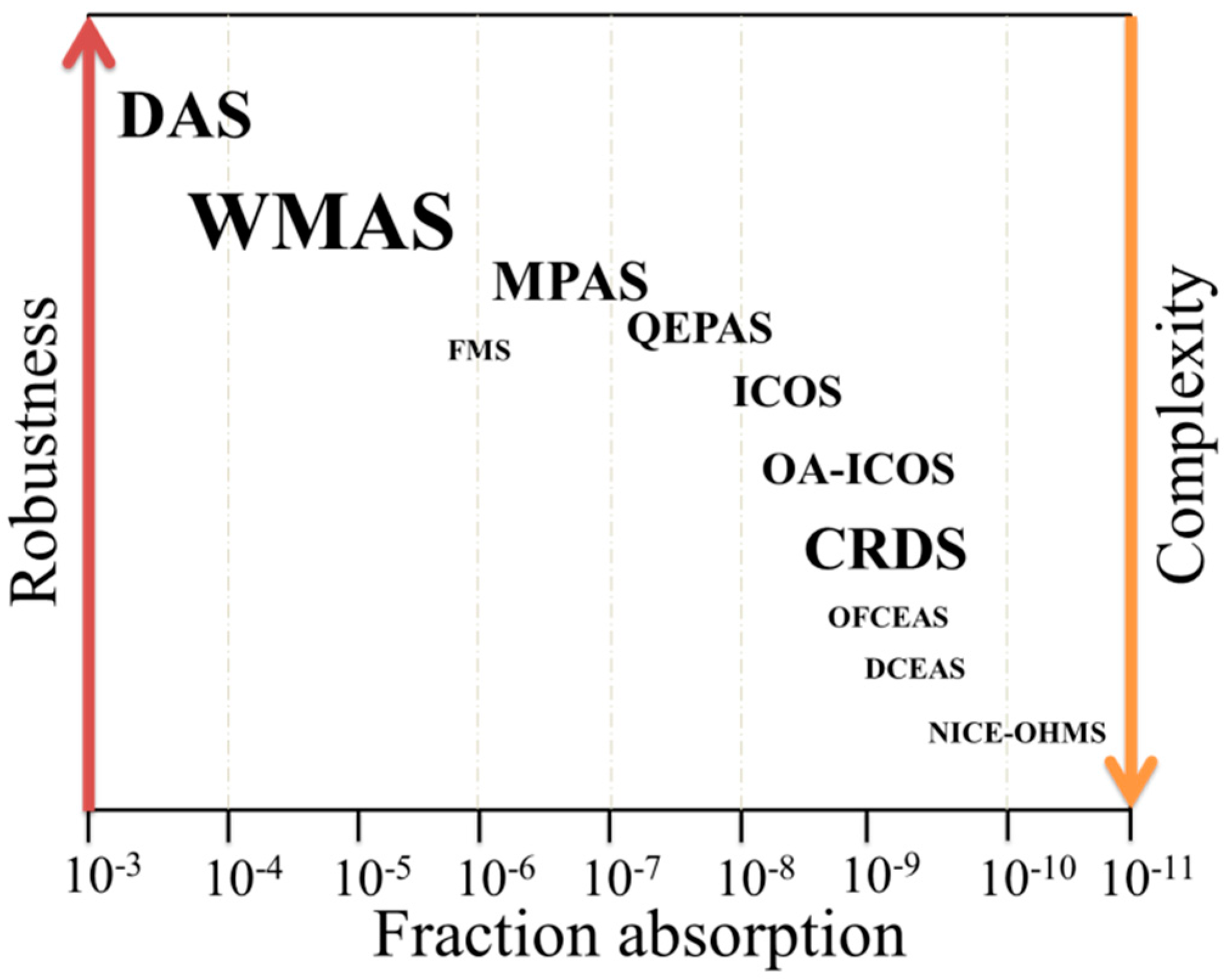
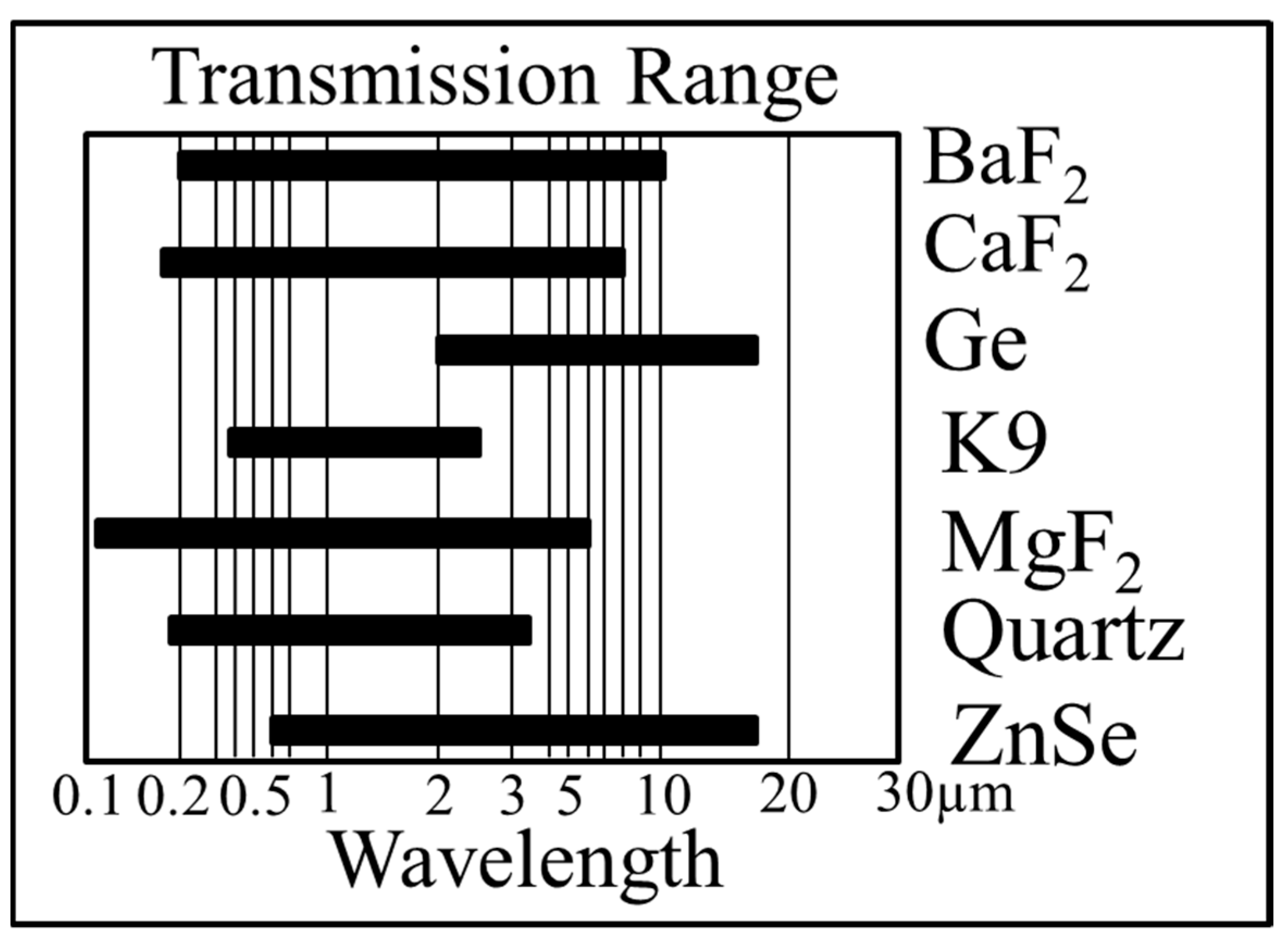
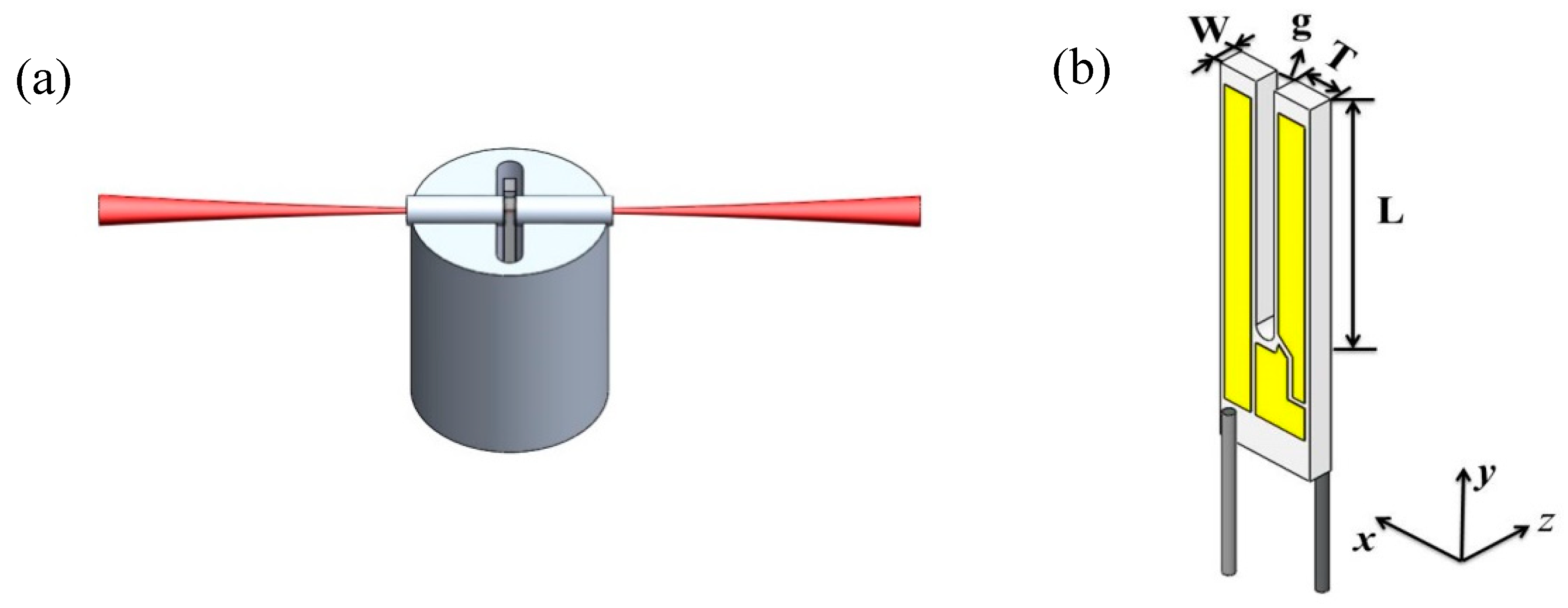
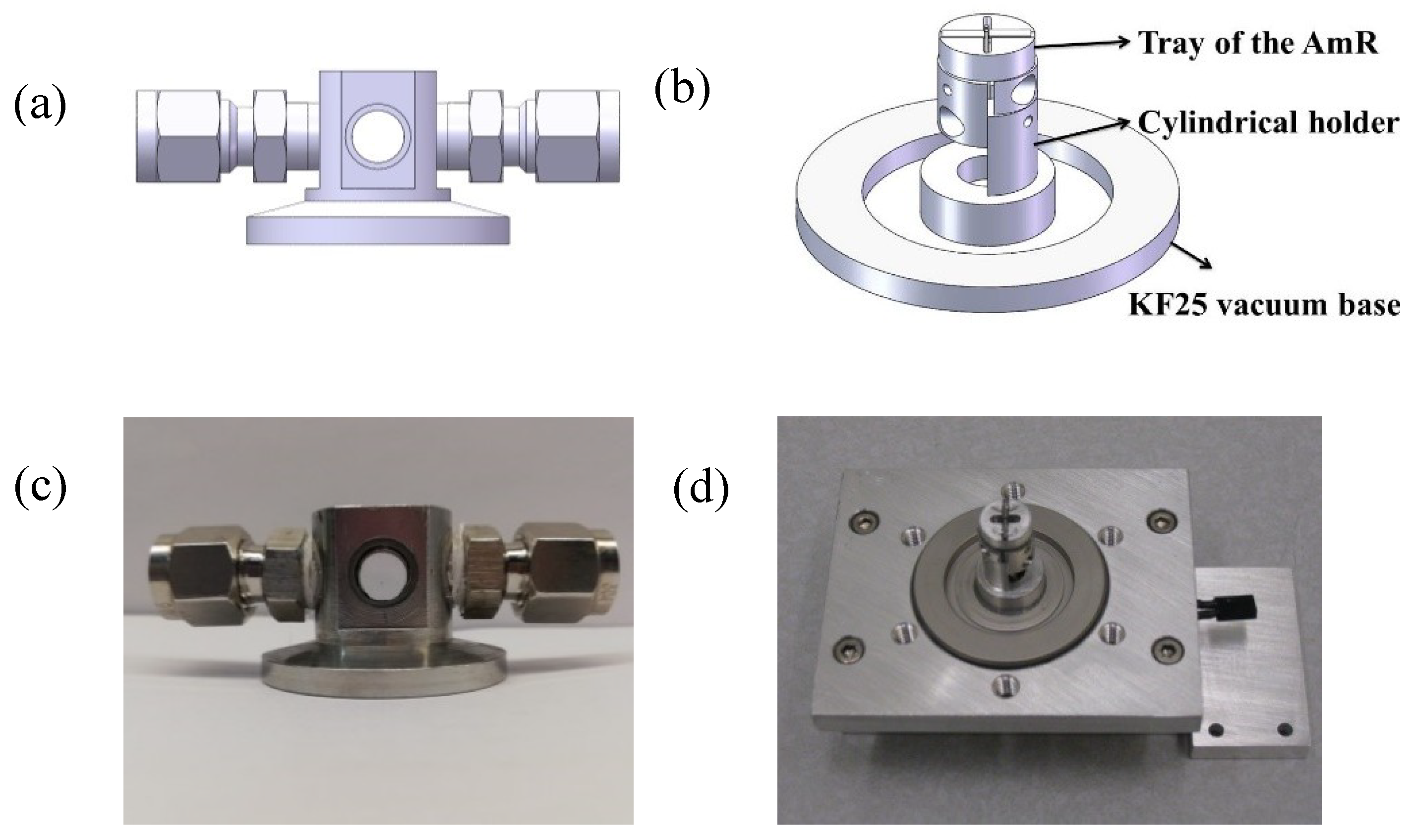
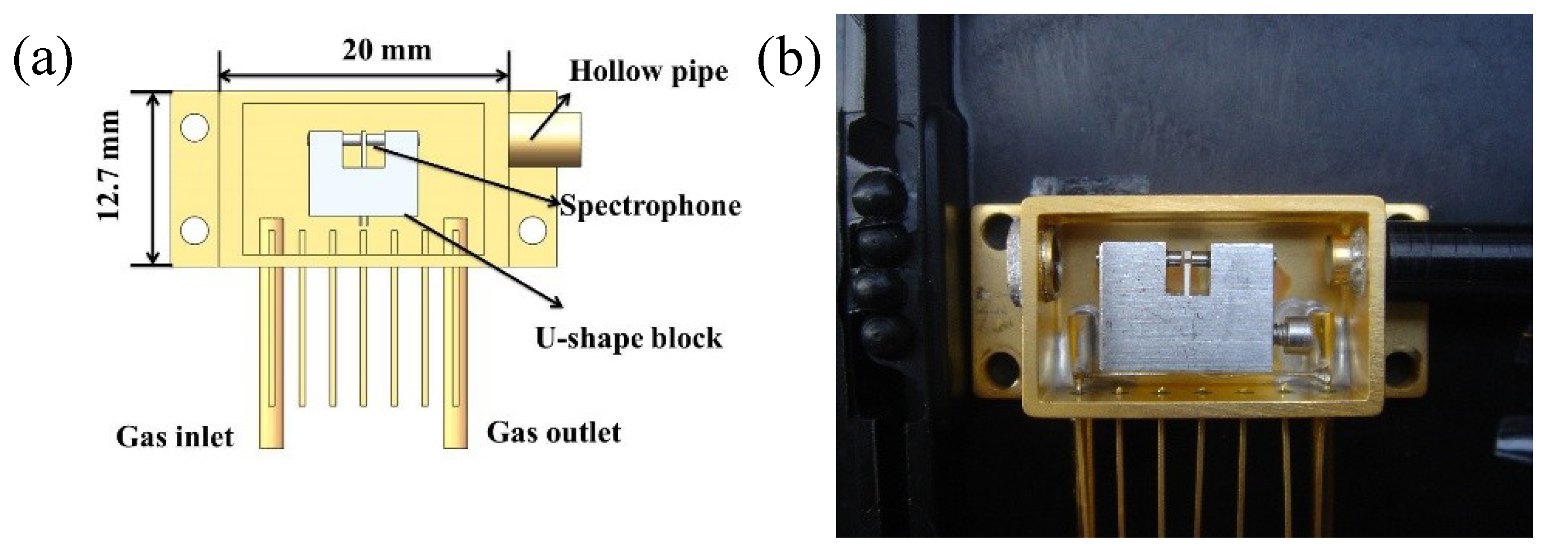


| g (mm) | L (mm) | T (mm) | f (Hz) | Q | |
|---|---|---|---|---|---|
| QTF#1 | 0.4 | 3.5 | 0.2 | 14,049.2 | 7323.69 |
| QTF#2 | 0.8 | 10 | 0.9 | 7230.27 | 18,654.18 |
| QTF#3 | 0.5 | 10 | 1 | 8439.51 | 25,484.95 |
| QTF#4 | 0.6 | 11 | 0.5 | 3456.69 | 8388.12 |
| QTF#5 | 0.7 | 17 | 1 | 2869.07 | 11,901.88 |
| QTF#6 | 1 | 19 | 1.4 | 4250.01 | 37,712.74 |
| g (mm) | L (mm) | T (mm) | f (Hz) | Q | |
|---|---|---|---|---|---|
| QTF-S08 | 0.8 | 9.4 | 2 | 15,841.92 | 15,710 |
| QTF-S15 | 1.5 | 9.4 | 2 | 15,801.66 | 15,400 |
| QTF-S08-T | 0.8 | 9.4 | 2 | 12,460.55 | 15,540 |
| QTF-S08-G | 0.8 | 9.4 | 2 | 15,222.93 | 15,050 |
| Molecule (host) | Wavenumber (cm−1) | Pressure (hPa) | Power (mW) | NNEA (cm−1W/Hz1/2) | NEC (ppmv) | Reference |
|---|---|---|---|---|---|---|
| CO (N2 + H2O) | 4291.5 | Atmospheric pressure | 8.8 | 1.8 × 10−5 | 11.2 | [5,30,44,45] |
| NO (N2) | 1900.075 | 333.323 | 100 | 3.6 × 10−9 | 0.015 | [31] |
| CO2 (air) | 6361.25 | Atmospheric pressure | 40 | 2.2 × 10−9 | 29 | [32,33,38] |
| NH3 (N2) | 6322.45 | Atmospheric pressure | 1250 | 1.395 × 10−9 | 0.5 | [35,38,39,46] |
| NO2 (N2) | 2415.40 | Atmospheric pressure | 7 | 4.2 × 10−9 | 0.0013 | [36,37] |
| H2O (N2) | 7306.75 | 79.997 | 9.5 | 1.9 × 10−9 | 0.09 | [38] |
| C2H2 (N2) | 6523.88 | Atmospheric pressure | 57 | 4.1 × 10−9 | 0.03 | [38] |
| H2S (N2) | 6328.88 | Atmospheric pressure | 1250 | 1.525 × 10−9 | 1.6 | [39] |
| HCN (air) | 6539.11 | 79.997 | 50 | 4.6 × 10−9 | 0.155 | [40] |
| H2S (N2) | 6320.6 | Atmospheric pressure | 1.4 | 9.8 × 10−9 | 0.142 | [41] |
| C2H4 (N2) | 6177.14 | Atmospheric pressure | 15 | 5.4 × 10−9 | 1.7 | [43] |
| N2O (N2 + 5%SF6) | 2195.633 | 66.664 | 19 | 1.5 × 10−8 | 0.007 | [44,45] |
| CH2O (N2) | 2832.50 | Atmospheric pressure | 3.4 | 2.2 × 10−8 | 0.6 | [48] |
| CO2 | 6493.42 | Atmospheric pressure | 21.1 | 16 × 10−9 | 0.692 | [29,52,53] |
| C2H2 (N2) | 6523.87 | 599.981 | 58.0 | 1.9 × 10−9 | 0.03 | [29,51] |
| HCN (N2) | 6539.11 | Atmospheric pressure | 35.5 | 5.3 × 10−9 | 0.45 | [51,53] |
| NH3 (N2) | 6528.80 | 599.981 | 62.0 | 6.9 × 10−9 | 0.1 | [51,54] |
| H2S (N2) | 6320.6 | Atmospheric pressure | 38.3 | 5.8 × 10−9 | 10.1 | [52] |
| CH4 (N2) | 6057.09 | Atmospheric pressure | 16.0 | 1.1 × 10−8 | 1.5 | [52,54] |
| CO (N2 + 1.1%H2O) | 4288.29 | Atmospheric pressure | 2.0 | 1.41 x10−8 | 7.74 | [53] |
| HCL (N2) | 5739.26 | Atmospheric pressure | 14.7 | 5.17 × 10−8 | 1.48 | [53] |
| NO (N2 + 2.5%H2O) | 1900.08 | 279.991 | 66 | 5.6 × 10−9 | 0.0049 | [55] |
| CO (N2 + 2.2%H2O) | 2176.28 | 133.329 | 71 | 1..48 × 10−8 | 0.002 | [56,57] |
| N2O (N2 + 2.6%H2O) | 2169.60 | 133.329 | 400 | 2.91 × 10 −9 | 0.023 | [57] |
| CO2 (N2) | 6361.25 | Atmospheric pressure | 40 | 1.21 × 10−8 | 90 | [21] |
| H2O (N2) | 7306.75 | Atmospheric pressure | 13 | 1.73 × 10−9 | 0.23 | [22,65] |
| H2S (N2) | 6320.60 | Atmospheric pressure | 1520 | 1.29 × 10−8 | 0.89 | [64] |
© 2019 by the authors. Licensee MDPI, Basel, Switzerland. This article is an open access article distributed under the terms and conditions of the Creative Commons Attribution (CC BY) license (http://creativecommons.org/licenses/by/4.0/).
Share and Cite
Wei, T.; Wu, H.; Dong, L.; Tittel, F.K. Acoustic Detection Module Design of a Quartz-Enhanced Photoacoustic Sensor. Sensors 2019, 19, 1093. https://doi.org/10.3390/s19051093
Wei T, Wu H, Dong L, Tittel FK. Acoustic Detection Module Design of a Quartz-Enhanced Photoacoustic Sensor. Sensors. 2019; 19(5):1093. https://doi.org/10.3390/s19051093
Chicago/Turabian StyleWei, Tingting, Hongpeng Wu, Lei Dong, and Frank K. Tittel. 2019. "Acoustic Detection Module Design of a Quartz-Enhanced Photoacoustic Sensor" Sensors 19, no. 5: 1093. https://doi.org/10.3390/s19051093
APA StyleWei, T., Wu, H., Dong, L., & Tittel, F. K. (2019). Acoustic Detection Module Design of a Quartz-Enhanced Photoacoustic Sensor. Sensors, 19(5), 1093. https://doi.org/10.3390/s19051093








